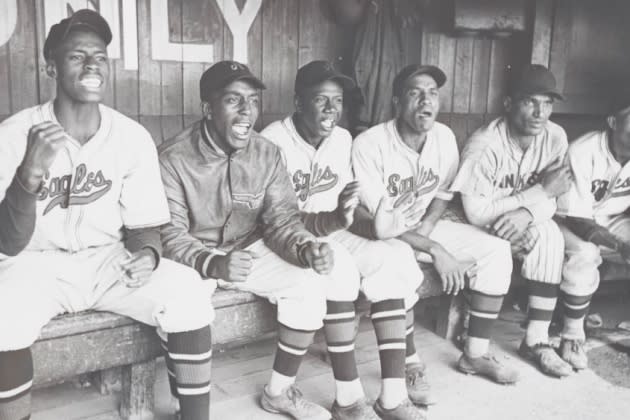‘The League’ Review: The Negro Leagues Finally Get Their Due in Moving Baseball Documentary
- Oops!Something went wrong.Please try again later.
- Oops!Something went wrong.Please try again later.
- Oops!Something went wrong.Please try again later.

There’s no shortage of great movies about baseball, but there is a severe lack of films about the Negro leagues. The fifth inning of Ken Burns’ expansive “Baseball” covers them with admirable reverence, but feature-length projects — whether narrative or documentary — are vanishingly rare. “The League” is therefore something close to required viewing for devotees of our national pastime just by virtue of its existence, so it comes as a relief that Sam Pollard’s documentary (exec produced by Ahmir “Questlove” Thompson) is also quite good on the merits.
Given his résumé, that shouldn’t come as a surprise. Pollard’s prior work as director includes “MLK/FBI” and “Citizen Ashe,” and he’s also edited several Spike Lee joints; in addition to a Peabody Award and career achievement prize from the International Documentary Association, he shared an Oscar nomination with Lee for 1997’s “4 Little Girls” about the 16th Street Baptist Church bombing.
More from Variety
'Lost Soulz' Review: A Hip-Hop Musical Buoyed by Original Compositions from Its Talented Cast
'Every Body' Review: A Frank Discussion of Intersex Identity Holds Keys to the Culture Wars
One of the film’s earliest, most important points is that the color line broken by Jackie Robinson in 1947 didn’t come into being the moment baseball was invented. Players like Moses Fleetwood Walker and William Edward White (who passed as white) were in the majors as early as the 1870s. Baseball’s segregation was formalized over the next decade, and the Negro leagues followed. And though separate was never truly equal, “The League” makes it clear that the Negro National League, Eastern Colored League and other organizations absolutely thrived. Interviewees such as Negro Leagues Baseball Museum President Bob Kendrick celebrate these achievements without forgetting that they only existed in the first place due to systemic racism — the Negro leagues’ central paradox, and a dynamic to which Pollard devotes much of his attention.
That balance — highlighting just how lively and entertaining the Negro leagues were while also being mindful of the cultural forces that necessitated them — is present throughout “The League.” When Kendrick describes the style of play as “fast, aggressive, daring,” you’ll want to find archival footage and watch a game to see each stolen base and flashy infield play for yourself. When, moments later, a voice actor narrates an umpire’s recollection of paying 10 cents to go to a game, you’ll wish you could have too. If one measure of a documentary’s quality is whether it inspires you to learn more about its subject after the credits roll, “The League” is an unqualified success.
Many of these leagues were regional organizations composed of just six or eight clubs, with veritable all-star teams like the Homestead Grays, Pittsburgh Crawfords, and Kansas City Monarchs getting special attention here — including the fact that, in occasional exhibition matches against MLB teams, Negro league clubs emerged victorious more often than not. Robinson is rightly remembered as one of America’s most towering athletic figures for breaking the color line, but Negro league luminaries like Josh Gibson and Turkey Stearnes have remained relatively unsung. Combining new interviews filmed specifically for the documentary with previously recorded conversations of former players and historians, Pollard goes a long way toward reversing that trend.
A number of those interviewees are as lyrical as they are knowledgeable. Larry Lester describes Robinson as “an inkspot on the white canvas of injustice,” while the same umpire from earlier recalls, “In those moments, responding to racism, we weren’t playing as umpires and managers; we were brothers.” Being celebrated on the field didn’t prevent them from being discriminated against off of it, of course. While some of the stories of being denied entry to hotels and restaurants are all too familiar, some are so specific as to startle anew. Hank Aaron remembers having to live off of peanut butter and bread for several days, while Satchel Paige and his teammates once had to sleep on their suitcases in the ballpark after a game because there was nowhere else to stay.
One of the most compelling sequences has little to do with baseball on its face. The history of the Negro leagues extends through both World Wars, the second of which inspired the Double Victory campaign: “victory abroad and victory at home.” As the movement initially launched by the Pittsburgh Courier gained momentum, an increasing number of Black soldiers demanded that the country they were fighting and dying for stop treating them like second-class citizens if and when they returned to it — including being allowed to play the national pastime alongside white players. Pollard makes it clear that, though slow and hard-fought, their battle was ultimately successful.
The film ends, as it must, by examining the ramifications of Robinson breaking the color barrier — a massive, necessary event that also signaled the Negro leagues’ demise once more talented Black players followed. Here, too, “The League” strikes a balance between the celebratory and the elegiac. Though Kendrick opines that “progress came at a cost,” it’s clear that he, every other interviewee and Pollard himself believe that price was worth it.
Best of Variety
Sign up for Variety’s Newsletter. For the latest news, follow us on Facebook, Twitter, and Instagram.
